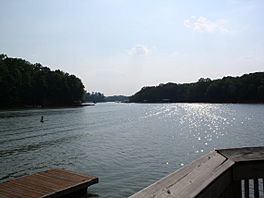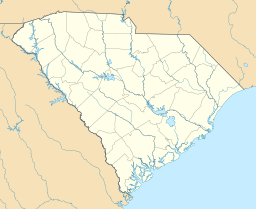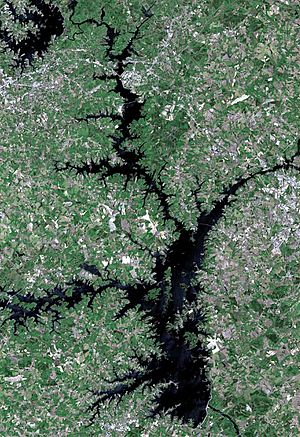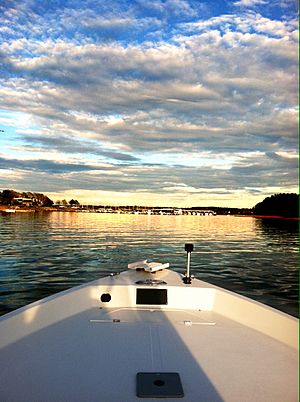Lake Hartwell facts for kids
Quick facts for kids Lake Hartwell |
|
|---|---|

A finger of the lake extends into Clemson, SC.
|
|
| Location | Georgia / South Carolina |
| Coordinates | 34°27′N 82°51′W / 34.45°N 82.85°W |
| Type | Reservoir |
| Primary inflows | Savannah, Tugaloo, and Seneca Rivers |
| Primary outflows | Savannah River to Lake Russell |
| Basin countries | United States |
| Surface area | 56,000 acres (23,000 ha) |
| Average depth | 45 ft (14 m) |
| Max. depth | 185 ft (56 m) |
| Surface elevation | 660 ft (201 m) |
Lake Hartwell is a huge, man-made lake located on the border of Georgia and South Carolina. It was created by building a dam across parts of the Savannah, Tugaloo, and Seneca rivers. This lake is one of the biggest and most popular spots for fun and relaxation in the southeastern United States.
The lake was formed by the Hartwell Dam, which was finished in 1962. The dam is on the Savannah River, about seven miles (11 km) downstream from where the Tugaloo and Seneca rivers meet. Lake Hartwell stretches for about 49 miles (79 km) up the Tugaloo River and 45 miles (72 km) up the Seneca River. It covers almost 56,000 acres (230 km²) of water and has a shoreline that is 962 miles (1,548 km) long. The entire Hartwell "Project" includes 76,450 acres (309 km²) of land and water. Interstate 85 cuts right through Lake Hartwell, making it easy for visitors to reach.
Contents
Building Lake Hartwell
The idea for Hartwell Dam and Reservoir came from a plan to develop the Savannah River Basin. The project was approved in 1950. Its main goals were to control floods and produce electricity.
Construction of the Hartwell project began in 1955 and was completed in 1963. The dam itself was built between 1955 and 1959. Before the lake was filled with water, experts studied the area. They looked for old artifacts and information from ancient and historical sites that would soon be underwater. Dr. Joseph Campbell and his team from the University of Georgia led this important work from 1957 to 1959.
Lake Hartwell is named after Nancy Hart, a brave woman from the American Revolutionary War. Nancy Hart lived in Georgia and was known for her strong belief in freedom. Many places, like a county, a city, a state park, and a highway, are named after her.
Lake Hartwell's Water Levels
Lake Hartwell's water levels can change a lot, especially during dry periods. In 1989, the lake dropped to a very low level because of a drought. It happened again in 2008. In December 2008, the lake was more than 22 feet (6.7 m) below its usual level.
When the water level drops, some interesting things appear. Old roads that were usually underwater become visible. Islands that are normally marked with buoys to warn boaters also show more land. Sometimes, boats are even left sitting on dry ground! The lowest the lake has ever been was 637.49 feet (194.31 m) on December 9, 2008. The highest it has been was 665.4 feet (202.8 m) on April 8, 1964. On average, the lake's elevation is about 657.5 feet (200.4 m).
Ancient History of the Lake Area
The land around Lake Hartwell has a long and interesting history. Long before European settlers arrived, indigenous people lived here. This includes the Mississippian culture, which started around 800 CE. These people built many villages and large platform mounds along the rivers that feed into the Savannah River, like the Chauga, Tugaloo, and Seneca rivers.
The Cherokee people later settled in this area, making it their homeland. At first, they traded with the European colonists. But after the American Revolutionary War, more and more settlers moved onto Cherokee lands. Today, many streams, rivers, and recreation areas are named after the historic Cherokee and Muscogee Creek tribes. These tribes were among the "Five Civilized Tribes" who were forced to leave their homes in the Southeast in the 1830s.
A young indigenous woman named Issaqueena is said to have named some of the streams. She rode to Fort Ninety-Six to warn settlers about an attack. As she traveled, she named streams based on how many miles she had covered. This is how Six-Mile, Twelve-Mile, Three-and-Twenty Mile, and Six-and-Twenty Mile creeks got their names. These creeks are still part of the lake today. Other important historical figures who lived nearby include Andrew Pickens and John C. Calhoun, who were both famous politicians from South Carolina. The botanist William Bartram also explored this area, studying its plants.
Challenges During Construction
Building a large lake like Hartwell wasn't always easy. In 1956, a woman named Mrs. Eliza Brock and her daughter refused to let workers onto their property. The government had bought 103 acres of land from them, but Mrs. Brock felt she hadn't received a fair offer. After a federal court ruling, Mrs. Brock eventually agreed to accept $6,850 for her land.
Later in 1956, Clemson College also had concerns. They worried that the new lake would flood parts of their property, including their football stadium. After many meetings, Clemson reached an agreement with the government. They decided to build two special dams near Clemson College. These dams would redirect the Seneca River around the college's property, protecting it from flooding.
Fishing in Lake Hartwell
Since it was built, Lake Hartwell has become a great place for fishing. You can find many types of fish here naturally, like bream, catfish, smallmouth bass, walleye, and largemouth bass.
However, the most popular fish to catch in Lake Hartwell is the striped bass. These fish are usually found in saltwater. But after a dam was built on the Santee-Cooper system in South Carolina, many striped bass got trapped in freshwater and learned to survive there. Because of this, striped bass were later introduced to Lake Hartwell and two other lakes in the Savannah River System. Fishermen have caught striped bass weighing over 60 pounds (27 kg) in Lake Hartwell! It's common to catch 20-pound (9 kg) fish, but most striped bass caught here weigh between 5 and 12 pounds (2.3 and 5.4 kg).
Fun Activities at Lake Hartwell
Lake Hartwell offers many ways to have fun outdoors!
- Camping. The U.S. Army Corps of Engineers manages 9 campgrounds around Lake Hartwell. They have a total of 524 campsites. Many campgrounds offer restrooms, showers, boat ramps, playgrounds, and places to swim.
- Biking Trail. There's a 7.6-mile (12.2 km) multi-purpose trail at the Paynes Creek Campground. It's great for biking and walking.
- Fishing. As mentioned, Lake Hartwell is a fantastic spot for fishing. You can catch many different kinds of fish here.
- Swimming. The lake is a popular place to swim. Always remember to be safe and wear a life jacket, especially if you are not a strong swimmer.
- Water Sports. The lake is perfect for exciting water sports like tubing, water skiing, and wakeboarding.
- Boating. Boating is a huge part of life on Lake Hartwell. There are five marinas and many public boat ramps. The Western Carolina Sailing Club even hosts a yearly boat race in October.
- Wildlife. Lake Hartwell is home to lots of animals! You can find over 250 different kinds of birds and 40 different types of mammals living around the lake.
Cool Places to Visit Around the Lake
- Issaqueena Dam. This dam is located along the Keowee River. It has a beautiful waterfall that is about 25 feet (7.6 m) tall and 150 feet (46 m) wide. The waterfall carries extra water from Lake Issaqueena into Lake Hartwell. There are signs warning people to be careful here, and it's always a good idea to wear a life jacket.
- Eighteen Mile Creek. This creek is a winding and narrow waterway that connects to the Seneca River. It's a favorite spot for fishermen and people who love to watch birds. The creek stretches for about five miles (8 km) and ends in a shallow area with an old bridge. It's a great place to see many birds and other wildlife.
- Rock Quarry. This area has many rocks that hang over the water. Their height seems to change depending on how high the lake's water level is. Some parts of this cove are shallower than others.
- Ghost Island. This is the largest island on the lake. In the middle of the island, there are about fifty old grave headstones. Some of them are hard to read. Some graves are marked from the War of 1812, and others are even older, from the 1700s. Many people camp on this island without knowing about its "company"!
- Andersonville Island. Andersonville, South Carolina, used to be a busy port and resort town. It had a barge system that traveled daily to Savannah, Georgia. It was a thriving place with industries and tourists. Today, it's a large island, almost 400 acres (160 ha) in size. It's the biggest island on the lake, about two to three miles (3.2 to 4.8 km) long. An old paved road crosses the island, but it's now overgrown. Visitors can explore old building ruins, artifacts, and see rare plants and wildlife.
- Clemson Football. Clemson football games are a big draw for boaters on Lake Hartwell. The university and its stadium stand tall over the lake. During football season, boaters travel up the Seneca River to watch the games. Boats park near the stadium, and people walk up the hill to enjoy the game day atmosphere. Traveling by boat to Clemson from the Hartwell Dam area takes about 30 to 40 minutes.




